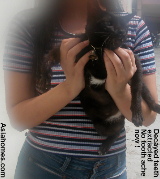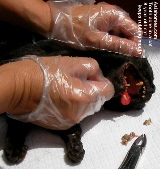| 0417Singapore
cat tooth decay, ache, pet health and welfare educational for animal lovers,
excerpts from The
Glamorous Vets, Singapore, sponsored by AsiaHomes Internet.
May 02, 2002 The cat had seven lives after seeing the vet  "You
said the kitten would die," said Mrs Chow. "She had blood coming
out of her nose after being knocked down by a car. It is still alive after
eight years!" I had not seen Mrs Chow for the past years and
frankly, I could not recall this case. I had given a poor prognosis
and now, the feline patient had only used up one of her nine lives to
taunt me now. "You
said the kitten would die," said Mrs Chow. "She had blood coming
out of her nose after being knocked down by a car. It is still alive after
eight years!" I had not seen Mrs Chow for the past years and
frankly, I could not recall this case. I had given a poor prognosis
and now, the feline patient had only used up one of her nine lives to
taunt me now. "What is the cat suffering from now?" I asked as I saw salivation dripping from a half-opened mouth of this thin female black cat with a central patch of deep blue scar on the front of the cornea. "She kept pawing the side of her mouth," said Mrs Chow. "Did you give fish bones to the cat?" I asked. A fish bone lodged inside the mouth could be irritating for the cat. "No," Mrs Chow replied. "This cat never went out of the house nor ate any fish. She was given pelleted cat feed only." Mr Chow was getting impatient for some unknown reason. One reason could be the stress of looking out for the grey uniformed car parking wardens. The car park warden might make surprise rounds to book cars which did not display a car parking coupon in this industrial park. All drivers had to tear out slabs of year, month, day and time on the coupon for $0.45 per hour. A fine of $30.00 would be imposed if caught napping. However, a few questions needed to be asked first to get the history and to form a tentative diagnosis. Since the fish bone foreign body was ruled out, the next probable cause of salivation and mouth pain would be periodontal disease, a common condition in old cats all over the world. Pieces of food got lodged around the teeth. Over the last eight years, millions of bacteria gathered at the food pieces and infected the gums as the cat could not brush or floss its teeth daily unlike people. The gums became red and swollen and bled easily. A thin brownish layer called plaque covered the teeth surface. Bacteria in the plaque continued to destroy the gum and surrounding bone tissue. This would the early stage of periodontal disease and is known as gingivitis. Regular yearly dental scaling to remove the plaque would help the cat to retain its teeth to old age. The cat resisted my opening her mouth. I could see the upper molar teeth encrusted by thick tartar and some loose teeth. The plaque had hardened into a rough, porous substance called calculus or tartar as I could see from the anaesthesized cat. At this age, the cat was suffering from advanced periodontal disease, having passed the mild and moderate periodonititis stage. It must be very painful to have tooth decay. Toxins or poisons produced by the bacteria in the tartar had destroyed the gums and the bone tissue supporting the root of the molar teeth. The disease had progressed over the years as more bacteria and toxins extended deeper into the bone holding the tooth in place. Many teeth had fallen out, but a few molars did not. She was now a very thin cat with a severe tooth ache such that she had to slap her face to ease the pain. If only she could talk, she would have told her owner.. Thee tooth ache affected her appetite and enjoyment of eating. The bacteria had invaded her heart valves and she was a risk under anaesthesia. Would she be strong enough to take the tranquiliser without dying? "$90 for the tooth extraction and scaling is expensive," said Mr Chow with a worried smile. "The dentist at Ang Mo Kio charges less for human patients. Times are bad. Can you reduce the fees?" I did not think so but it would be impolite to argue and compare with human medicine and surgery. People going for tooth extraction would not require general anaesthesia generally and the cost would be lower. No animal would permit tooth extraction under local anaesthesia. It was not possible to inject local anaesthesia into the gums. "It included tranquiliser, antibiotics and an overnight cage rest. The cat would be bleeding in the mouth after extraction and should be rested here." I said. "My normal charges with general anaesthesia are $150 - $200". Vets nowadays have to be competitive with human doctors and dentists too. This was the worst recession in Singapore.  I
kept my fingers crossed as I tranquilised the cat. Her heart was still
good but death from cardiac failure could happen in anaesthesia for high
risk old and thin patients. I
kept my fingers crossed as I tranquilised the cat. Her heart was still
good but death from cardiac failure could happen in anaesthesia for high
risk old and thin patients. I used gas mask to further reduce the pain of extraction of the decayed teeth. Most teeth had dropped out through the years but there were the stubborn big molars which were loose but would not drop off by themselves. I scaled the yellow and chocolate brown stains off the surface of the remaining good teeth. The shrill noise of the dental scaling disturbed the cat. She tried to get up  and
scratch me.
More gas anaesthesia calmed her. Gas anaesthesia would lessen the
risk of death compared to barbiturate injections which would be given in
the old days. Still the vet had to be very alert and careful. Dead
patients bad mouthing of the veterinarian spread like wild fire from
owners to owners in a small island of Singapore. and
scratch me.
More gas anaesthesia calmed her. Gas anaesthesia would lessen the
risk of death compared to barbiturate injections which would be given in
the old days. Still the vet had to be very alert and careful. Dead
patients bad mouthing of the veterinarian spread like wild fire from
owners to owners in a small island of Singapore. The cat did survive the operation. Mrs Chow was very happy. So was her daughter. Mr Chow did not appear so harassed when he came for the cat which was boarded for one night. The cat now had seven lives which is more than what people had! Mr Chow still parked his Mercedes far away from the clinic and had to keep an eye for the warden who nowadays come in the form of retirees on bicycles and motor cycles too. It would be hard to be so vigilant as the Housing and Development Board authorities got several ideas to generate revenue from the highly taxed motorists. Maybe he thought that the veterinarian would charge higher fees if the cat owner could afford a Mercedes, a prestige of the rich in Singapore. Plumbers and electricians are known to give higher quotations to owners of big bungalows and big cars and maybe other service providers would do so too! |